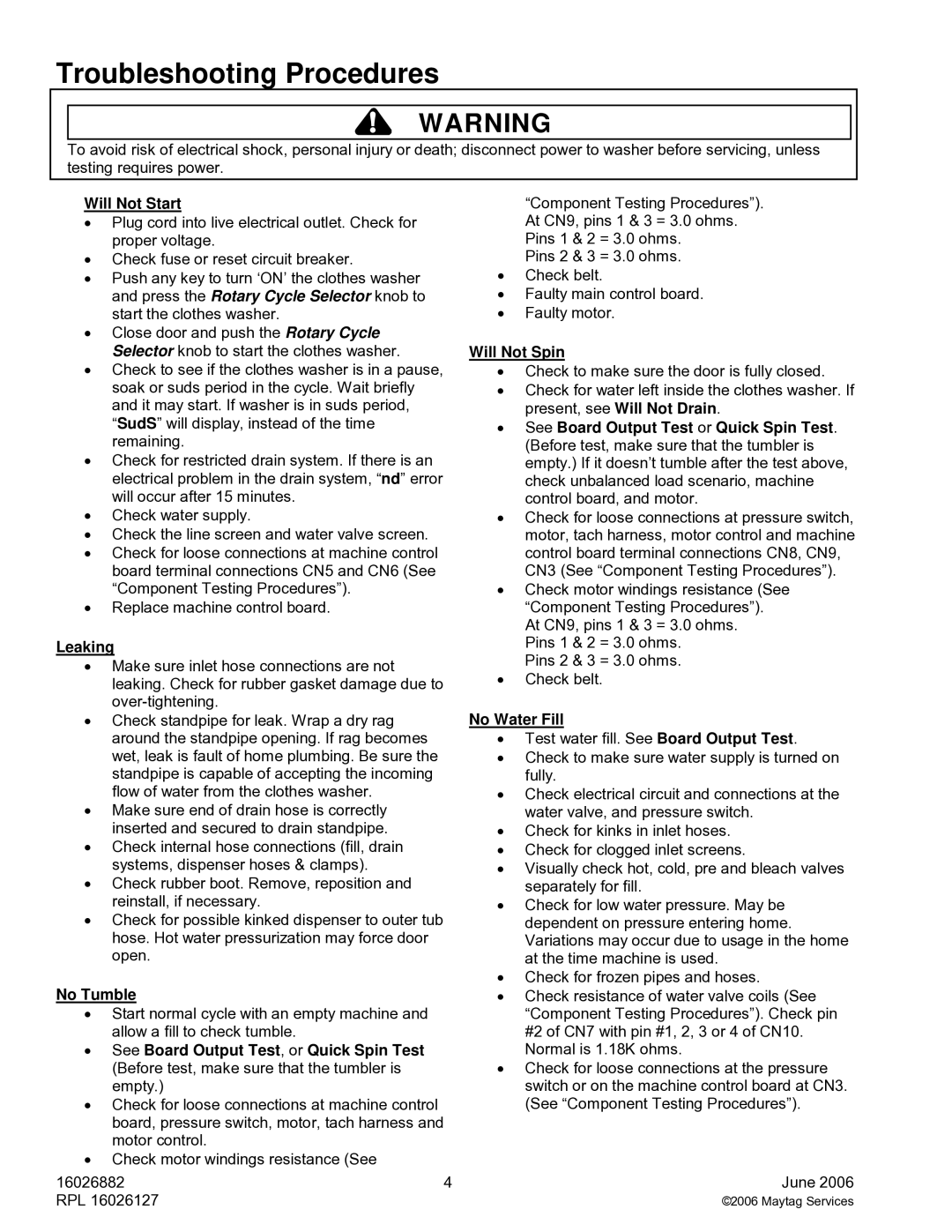
Troubleshooting Procedures
!WARNING
To avoid risk of electrical shock, personal injury or death; disconnect power to washer before servicing, unless testing requires power.
Will Not Start
•Plug cord into live electrical outlet. Check for proper voltage.
•Check fuse or reset circuit breaker.
•Push any key to turn ‘ON’ the clothes washer and press the Rotary Cycle Selector knob to start the clothes washer.
•Close door and push the Rotary Cycle Selector knob to start the clothes washer.
•Check to see if the clothes washer is in a pause, soak or suds period in the cycle. Wait briefly and it may start. If washer is in suds period, “SudS” will display, instead of the time remaining.
•Check for restricted drain system. If there is an electrical problem in the drain system, “nd” error will occur after 15 minutes.
•Check water supply.
•Check the line screen and water valve screen.
•Check for loose connections at machine control board terminal connections CN5 and CN6 (See “Component Testing Procedures”).
•Replace machine control board.
Leaking
•Make sure inlet hose connections are not leaking. Check for rubber gasket damage due to
•Check standpipe for leak. Wrap a dry rag around the standpipe opening. If rag becomes wet, leak is fault of home plumbing. Be sure the standpipe is capable of accepting the incoming flow of water from the clothes washer.
•Make sure end of drain hose is correctly inserted and secured to drain standpipe.
•Check internal hose connections (fill, drain systems, dispenser hoses & clamps).
•Check rubber boot. Remove, reposition and reinstall, if necessary.
•Check for possible kinked dispenser to outer tub hose. Hot water pressurization may force door open.
No Tumble
•Start normal cycle with an empty machine and allow a fill to check tumble.
•See Board Output Test, or Quick Spin Test (Before test, make sure that the tumbler is empty.)
•Check for loose connections at machine control board, pressure switch, motor, tach harness and motor control.
•Check motor windings resistance (See
16026882 | 4 |
RPL 16026127 |
|
“Component Testing Procedures”). At CN9, pins 1 & 3 = 3.0 ohms. Pins 1 & 2 = 3.0 ohms.
Pins 2 & 3 = 3.0 ohms.
•Check belt.
•Faulty main control board.
•Faulty motor.
Will Not Spin
•Check to make sure the door is fully closed.
•Check for water left inside the clothes washer. If present, see Will Not Drain.
•See Board Output Test or Quick Spin Test. (Before test, make sure that the tumbler is empty.) If it doesn’t tumble after the test above, check unbalanced load scenario, machine control board, and motor.
•Check for loose connections at pressure switch, motor, tach harness, motor control and machine control board terminal connections CN8, CN9, CN3 (See “Component Testing Procedures”).
•Check motor windings resistance (See “Component Testing Procedures”).
At CN9, pins 1 & 3 = 3.0 ohms. Pins 1 & 2 = 3.0 ohms.
Pins 2 & 3 = 3.0 ohms.
•Check belt.
No Water Fill
•Test water fill. See Board Output Test.
•Check to make sure water supply is turned on fully.
•Check electrical circuit and connections at the water valve, and pressure switch.
•Check for kinks in inlet hoses.
•Check for clogged inlet screens.
•Visually check hot, cold, pre and bleach valves separately for fill.
•Check for low water pressure. May be dependent on pressure entering home. Variations may occur due to usage in the home at the time machine is used.
•Check for frozen pipes and hoses.
•Check resistance of water valve coils (See “Component Testing Procedures”). Check pin #2 of CN7 with pin #1, 2, 3 or 4 of CN10. Normal is 1.18K ohms.
•Check for loose connections at the pressure switch or on the machine control board at CN3. (See “Component Testing Procedures”).
June 2006
©2006 Maytag Services
